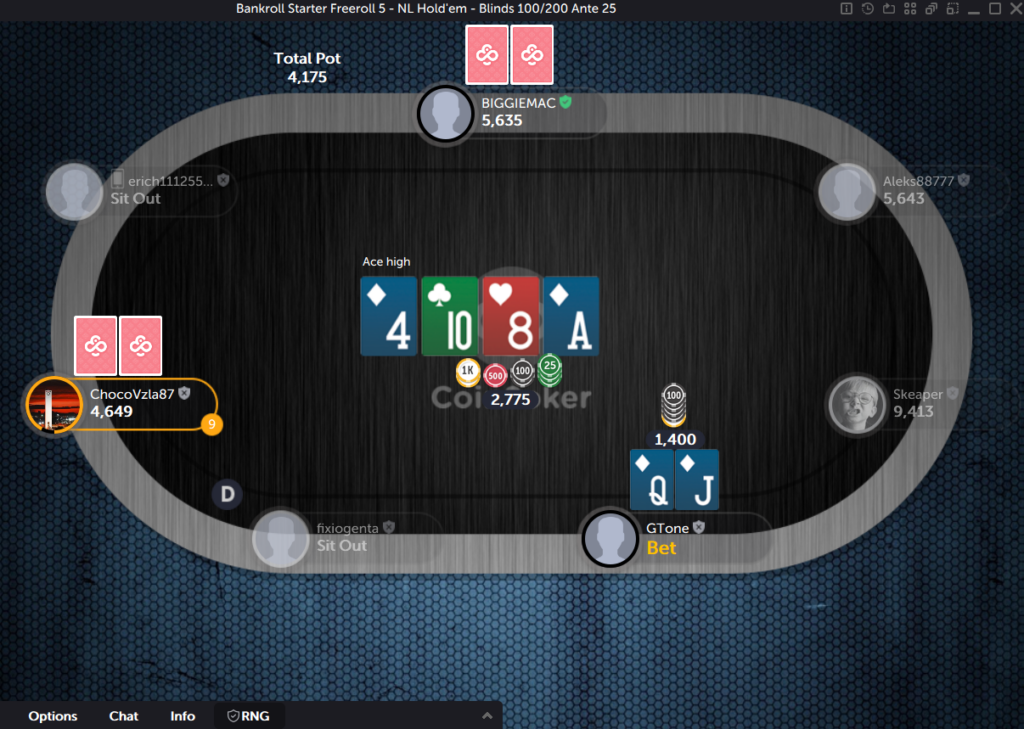Last Updated: 29 August 2025
Suited Connectors in Poker: How to Use These Valuable Hands
Players love suited connectors in poker, but few know how to use them. Here’s a guide to the hand, plus tons of useful suited connector strategies.
GuidesSuited connectors are a favorite poker hand amongst many players. These hands may not look powerful at first, but they can turn into some of the strongest hands in poker.
In this guide, we’ll cover the advantages of playing suited connectors, the best strategies, as well as some common pitfalls of playing these cards. At the end of our guide, you’ll be an expert in knowing how to play suited connectors.
What Are Suited Connectors in Poker?
Suited connectors in poker are hands made up of consecutive cards in the same suit, such as 8♥ 9♥ or 10♠ J♠. These hands offer a unique advantage due to their potential to form strong, valuable hands like straights, flushes, or even rare straight flushes, making them powerful options when played correctly. While suited connectors can be a game-changer, they require a strategic approach.
Not all suited hands with consecutive ranks are suited connectors. For instance, a hand like 8♥ 6♥, where one card is skipped in the sequence, is called a “suited gapper.” Unlike true suited connectors, suited gappers have less potential to form straights, making them a riskier choice overall.
The real strength of suited connectors lies in their flexibility and potential for winning combinations, especially when they hit favorable flops. However, suited connectors can also be costly if players overcommit without a strong hand or favorable board. Knowing when to play suited connectors, and understanding the risks and rewards they bring, is essential to making the most out of this versatile hand.

What Are the Best and Worst Suited Connectors?
The best suited connectors are high-value pairs like J♥ Q♥, 10♠ J♠, and 9♦ 10♦. These hands give players solid chances to make strong straights and flushes, which are often difficult for opponents to beat. For instance, with J♥ Q♥, you could hit a strong straight or flush on the flop, making these high suited connectors a potent option, especially when played in later positions.
On the other hand, low suited connectors like 3♣ 4♣ or 2♦ 3♦ generally have limited value. While they can make a straight or flush, these hands are dominated by stronger flushes or straights. Additionally, the lower card values make them more vulnerable to being out-kicked if you pair with an opponent.
Middle suited connectors, like 7♠ 8♠, offer a balance between these two extremes, providing moderate potential while carrying less risk than lower connectors.
How to Play Suited Connectors in Poker
Now that we understand what different suited connectors look like, let’s take a closer look at the best ways to play them in real live and online poker games. Suited connectors can be powerful hands when approached with the right strategy to maximize their potential. Below are four essential strategies to help you play suited connectors effectively, turning these hands into profitable assets.
Choose Higher Connectors for Aggressive Play
High-suited connectors like J♥ Q♥ or 10♠ 9♠ have better odds of forming high-value straights or flushes. These connectors are stronger in aggressive play, allowing you to confidently raise or call preflop, especially if you’re in a good (late) position. However, be cautious of situations where you might be out-ranked by an Ace-high flush, as this can turn a potentially winning hand into a losing one in flush-over-flush scenarios.
Look for Multiway Pots
Suited connectors perform well in multiway pots, if multiple players contribute to the pot, increasing the potential payout. When you hit a strong hand, like a flush, straight, or even a high draw, the return on your investment can be substantial, especially against multiple opponents.
If you only need to commit a small amount to see the flop, that is an excellent time to have suited connectors.
Adapt to the Table Dynamics
When playing suited connectors, it’s essential to adjust your strategy to the table dynamics. Suited connectors are ideal for looser tables where players are less likely to make aggressive preflop raises, giving you better odds of seeing the flop without over-committing. At tighter tables, however, players are more selective with their hands, which means you may need to play more cautiously. The competition for pots becomes tougher, and fewer players might enter the pot.
Be Prepared to Bluff
Suited connectors offer great bluffing opportunities, especially on boards with favorable textures, even when you miss the flop. When you’re in position, you can apply pressure to opponents particularly on boards that offer you straight or flush potential. This can cause opponents to fold better hands or prevent them from betting heavily. As a result, you have additional ways to build pots and win without having to hit the strongest hand on the flop.
Suited Connectors Preflop Strategy Tips
Playing suited connectors effectively preflop requires a keen sense of timing and position. Here are three quick tips to improve your preflop strategy with suited connectors:
- Play in Position
Position is critical for suited connectors. Acting last gives you valuable information on other players’ moves, allowing you to make better decisions based on their actions. This is especially helpful for determining whether to call, raise, or fold if the pot is getting large. - Use High Connectors More Aggressively
When holding high suited connectors, such as J♦ Q♦ or 10♠ 9♠, you can afford to be more aggressive preflop by raising or calling in late position. These hands have higher odds of forming strong combinations, making them safer for building the pot early. - Balance Small Raises with Limping
If the table is loose, consider limping (just calling the big blind) with low or mid suited connectors in order to see a cheap flop. Alternatively, a small raise can add pressure while giving you control of the pot. Balance these tactics based on the table’s dynamics.
Should You Raise Preflop with Suited Connectors?
Raising preflop with suited connectors can be a smart move, but it largely depends on your position and the strength of your connectors. When you’re in a late position, like the cutoff or the button, a preflop raise with higher suited connectors can put pressure on opponents and give you control over the pot. This move is especially effective at tighter tables where players are more likely to fold, allowing you to pick up the blinds or create favorable pot odds if they call.
However, raising with lower suited connectors from an early position can backfire. These hands have lower odds of hitting strong postflop combinations, so avoid aggressive preflop raises unless you’re in a good position.
Keep in mind that raising also opens up the possibility of getting 3-bet by aggressive players. If you face a 3-bet, evaluate your suited connectors’ strength and decide whether the potential pot odds or your hand’s expected value justify a call or fold.
Preflop Odds of Suited Connectors vs. Other Poker Hands
Suited connectors are intriguing preflop hands, often packed with potential to develop into strong holdings. However, their odds of winning can vary widely depending on the rank of the connectors and the type of hands they’re up against.
Below is a table that breaks down the winning chances of suited connectors versus a range of other hands.
| Hand Comparison | Winning Chance |
| High Suited Connectors (J♦ Q♦) vs. Lower Pocket Pair (5♠ 5♣) | 50.7% |
| Mid Suited Connectors (8♠ 9♠) vs. High Suited Connector (A♣ K♣) | 37.6% |
| Low Suited Connectors (5♣ 6♣) vs. Mid Pocket Pair (8♦ 8♥) | 20% |
| High Suited Connectors (10♠ J♠) vs. High Pair (K♦ K♠) | 19% |
| Mid Suited Connectors (7♠ 8♠) vs. Overcards (A♦ K♠) | 40.3% |
Suited Connectors Postflop Strategy Tips
Imagine you’re holding 8♠ 9♠, and the flop comes 7♠ 10♠ Q♦. You’ve now got a straight draw, a flush draw, AND a straight flush draw. This is a hand with tremendous potential!
Postflop, suited connectors can either thrive or fall short depending on the board texture, which can drastically change your hand’s chance of winning. In favorable conditions, suited connectors give you strong drawing opportunities, while unfavorable boards can quickly devalue your hand.
Here are some tips for making the most of suited connectors postflop:
- Evaluate Board Texture: Connectors thrive on “wet” boards, those with cards close in rank, which boost your odds of hitting straights and flushes.
- Play Cautiously with Low Connectors: On ‘dry’ boards (unconnected or paired), low suited connectors lose much of their value and are dominated by higher connectors.
- Consider Bluffing When You Have Draws: In position, leverage strong draws as bluffing opportunities, potentially making opponents fold better hands.
These strategies help you adapt to the changing value of suited connectors, maximizing your equity in poker and increasing your chances of winning big hands.

How Often Do Suited Connectors Hit the Flop?
Suited connectors can hit the flop in various ways, from pairs to strong draws. Below we look at the odds of different outcomes on the flop with a popular suited connector hand, J♦ 10♦:
| Flop Outcome | Odds with J♦ 10♦ |
| Flopping a Pair (J or 10) | 29% |
| Flopping Two Pair | 2% |
| Flopping Trips | 1.35% |
| Flopping a Straight | 1.3% |
| Flopping a Flush | 0.8% |
| Flopping a Full House | 0.1% |
When suited connectors like J♦ 10♦ go up against lower ones like 5♣ 6♣ preflop, there’s a clear advantage for the higher-ranked hand. J♦ 10♦ holds a 62.8% chance to win compared to the 36% odds of 5♣ 6♣ before reaching the flop.
Not only are higher-ranked suited connectors more likely to hit top pairs or strong draws, but they’re also less prone to being dominated by other hands. This difference in odds highlights why playing higher connectors leads to better overall results.
Common Suited Connector Mistakes You Can Avoid
Suited connectors can be profitable, but players often make costly mistakes when playing these hands. Here are some common missteps to watch out for:
- Overvaluing Hands Preflop: Players can easily fall in love with hands like J♠ 10♠, but without position or the right odds, investing too much early can lead to trouble.
- Chasing Weak Draws: Suited connectors often give tempting but low-value draws, like gutshots (inside straights). Relying on these weak outs can drain your stack if the odds don’t justify the risk.
- Ignoring Higher Flush Risks: Even if you hit a flush, suited connectors are frequently vulnerable to higher flushes. If the board shows a potential flush, always assess the risk of a better hand.
Avoiding these mistakes can make your suited connector play more profitable and help you stay out of difficult situations.
What Are Suited Gappers in Poker?
Suited gappers are hands with a gap between two suited cards, like 8♠ 10♠ or 6♥ 9♥. Suited gappers are separated by one or two ranks, known as “one-gappers” (e.g., 8♠ 10♠) and “two-gappers” (e.g., 6♥ 9♥).
Suited gappers can create strong hands, like straights or flushes, but they’re generally riskier than suited connectors. Their gap lowers the likelihood of completing a straight, meaning they often have less playability and fewer draw opportunities. However, when they do connect, they can be powerful against unsuspecting opponents, especially in loose games.
Let’s take a look at the odds of two suited gappers and a suited connector versus the popular starting hand A♠ K♠:
- Suited Connector (9♥ 10♥): This hand has a 38.5% chance to win against A♠ K♠ preflop. Suited connectors are versatile, capable of forming strong hands like straights, flushes, or even two pairs.
- One-Gapper (7♦ 10♦): With a gap of one rank, the odds drop slightly to a 37.7% chance to win against A♠ K♠ preflop. This hand is still playable but has reduced straight potential compared to a suited connector.
- Two-Gapper (7♦ 10♦): With a two-rank gap, the odds decrease further, giving it a 36.8% chance to win against A♠ K♠ preflop. It’s a more speculative holding and carries greater risk, especially against premium hands.
Understanding these subtle differences in odds can help you make smarter decisions with those hands.

Need Some Suited Connector Practice?
Ready to sharpen your skills with suited connectors? Practice in freerolls, cent-rolls, and low-stakes games where you can test strategies without significant risk. These games are great for learning when to bet, fold, and maximize suited connector potential.
Join CoinPoker today to dive into these practice games and start building your edge. Sign up now to get started and explore the wide range of games waiting for you!
FAQs
Suited connectors are consecutive cards of the same suit, like 9♠ 10♠.
Play suited connectors in multiway pots or with good table position.
High-value suited connectors like J♦ 10♦ or 10♠ 9♠ are generally best.
Low connectors like 2♣ 3♣ or 3♦ 4♦ offer fewer winning opportunities.
Yes, they can win big pots with straights or flushes depending on the board.
Explore More
Announcements
Read recent announcements from CoinPoker about new games, ambassadors, and changes to our platform.
8 PostsGuides
The go-to resource for mastering poker with expert tips and strategies. Whether you're a beginner or a pro, our guides will elevate your skill level.
60 PostsNews
Find the latest poker news from CoinPoker, plus our latest CoinPoker Weekly and Monthly Newsletters. Updates about games, promotions and other exciting crypto news.
88 PostsPromotions
Find the latest coinpoker promotions here. Explore the crypto poker world with the best poker promotions available.
1 Post
















